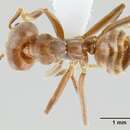en
names in breadcrumbs


Azteca instabilis is the largest species in the genus. It occurs in wet to dry forest habitats, usually below 500m elevation.
Azteca instabilis makes its nest in the hollow trunks of trees which have a large crevice or fissure at the base. When I encounter them, workers are issuing from the fissure in large numbers, usually ascending the tree and often blanketing the surrounding forest floor. In one case I was able to peer up into such a fissure, and I observed a very large carton nest filling the trunk cavity. Colonies can be long-lived. During extended field work at Sirena in Corcovado National Park, I frequently passed a large tree with a very active A. instabilis colony in the trunk, with workers flowing in and out of a large fissure at the base. I returned to the site 16 years later to find the same fissure with A. instabilis workers still active.
When examining Azteca queens in museum collections, A. instabilis is usually the most abundant species because the large queens frequently come to lights at night. This is in sharp contrast to most other Azteca, whose alate queens are usually encountered as diurnal strays, occasional specimens in Malaise traps, or parts of nest collections. This correlates with the fact that A. instabilis queen ocelli are absolutely and relatively far larger than ocelli on any other Azteca queen I have examined. The enlarged ocelli are not the result of an allometric relationship with head size, since A. sericea and A. sericeasur, with queens nearly as large, have tiny ocelli typical of smaller queens. Ocelli concentrate light and detect light of low intensity (Chapman 1982), suggesting a functional relationship between large ocelli and nocturnal habits.
Workers frequently forage on the surface, both day and night. They visit extrafloral nectaries, and may tend coccoid Hemiptera under small carton shelters.
Kempf (1972) lists A. instabilis from scattered localities in Brazil, the Guianas, Peru, Colombia, Panama, Costa Rica, Honduras, Guatemala, Belize, and Mexico. I have examined material from Mexico, Honduras, Nicaragua, Costa Rica, Panama, and Bolivia.
Taxonomic history
Emery, 1893l: 135 (s.); Emery, 1896a PDF: 2 (q.); Wheeler & Wheeler, 1951 PDF: 193 (l.).Combination in Liometopum: Mayr, 1878 PDF: 870.Combination in Azteca: Emery, 1893l: 135.See also: Wheeler, 1907b PDF: 276.Senior synonym of Azteca instabilis major: Longino, 2007 PDF: 35.